hucMSCs treatment prevents pulmonary fibrosis by reducing circANKRD42-YAP1-mediated mechanical stiffness
- PMID: 37335082
- PMCID: PMC10333056
- DOI: 10.18632/aging.204805
hucMSCs treatment prevents pulmonary fibrosis by reducing circANKRD42-YAP1-mediated mechanical stiffness
Abstract
Idiopathic pulmonary fibrosis (IPF) is a fibrosing interstitial pneumonia of unknown cause. The most typical characteristic of IPF is gradual weakening of pulmonary elasticity and increase in hardness/rigidity with aging. This study aims to identify a novel treatment approach for IPF and explore mechanism of mechanical stiffness underlying human umbilical cord mesenchymal stem cells (hucMSCs) therapy. Target ability of hucMSCs was examined by labeling with cell membrane dye Dil. Anti-pulmonary fibrosis effect of hucMSCs therapy by reducing mechanical stiffness was evaluated by lung function analysis and MicroCT imaging system and atomic force microscope in vivo and in vitro. Results showed that stiff environment of fibrogenesis caused cells to establish a mechanical connection between cytoplasm and nucleus, initiating expression of related mechanical genes such as Myo1c and F-actin. HucMSCs treatment blocked force transmission and reduced mechanical force. For further exploration of mechanism, ATGGAG was mutated to CTTGCG (the binding site of miR-136-5p) in the full-length sequence of circANKRD42. Wildtype and mutant plasmids of circANKRD42 were packaged into adenovirus vectors and sprayed into lungs of mice. Mechanistic dissection revealed that hucMSCs treatment repressed circANKRD42 reverse splicing biogenesis by inhibiting hnRNP L, which in turn promoted miR-136-5p binds to 3'-Untranslated Region (3'-UTR) of YAP1 mRNA directly, thus inhibiting translation of YAP1 and reducing YAP1 protein entering nucleus. The condition repressed expression of related mechanical genes to block force transmission and reduce mechanical forces. The mechanosensing mechanism mediated directly by circANKRD42-YAP1 axis in hucMSCs treatment, which has potential general applicability in IPF treatment.
Keywords: YAP1; circRNA; hucMSCs; mechanical stiffness; pulmonary fibrosis.
Conflict of interest statement
Figures
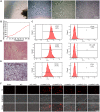
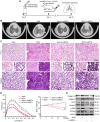
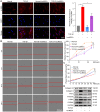

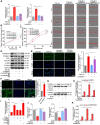
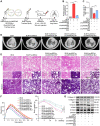
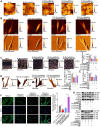

Similar articles
-
hnRNPL-activated circANKRD42 back-splicing and circANKRD42-mediated crosstalk of mechanical stiffness and biochemical signal in lung fibrosis.Mol Ther. 2022 Jun 1;30(6):2370-2387. doi: 10.1016/j.ymthe.2022.01.045. Epub 2022 Mar 10. Mol Ther. 2022. PMID: 35278674 Free PMC article.
-
Three-dimensional cultured human umbilical cord mesenchymal stem cells attenuate pulmonary fibrosis by improving the balance of mitochondrial fusion and fission.Stem Cells Transl Med. 2024 Sep 10;13(9):912-926. doi: 10.1093/stcltm/szae051. Stem Cells Transl Med. 2024. PMID: 39077914 Free PMC article.
-
circELP2 reverse-splicing biogenesis and function as a pro-fibrogenic factor by targeting mitochondrial quality control pathway.J Cell Mol Med. 2024 Feb;28(3):e18098. doi: 10.1111/jcmm.18098. Epub 2023 Dec 30. J Cell Mol Med. 2024. PMID: 38159063 Free PMC article.
-
Mechanical forces: The missing link between idiopathic pulmonary fibrosis and lung cancer.Eur J Cell Biol. 2022 Jun-Aug;101(3):151234. doi: 10.1016/j.ejcb.2022.151234. Epub 2022 May 10. Eur J Cell Biol. 2022. PMID: 35569385 Review.
-
MicroRNAs in idiopathic pulmonary fibrosis.Transl Res. 2011 Apr;157(4):191-9. doi: 10.1016/j.trsl.2011.01.012. Epub 2011 Feb 4. Transl Res. 2011. PMID: 21420029 Review.
Cited by
-
m6A‑modified HOXC10 promotes HNSCC progression via co‑activation of ADAM17/EGFR and Wnt/β‑catenin signaling.Int J Oncol. 2024 Feb;64(2):10. doi: 10.3892/ijo.2023.5598. Epub 2023 Dec 8. Int J Oncol. 2024. PMID: 38063205 Free PMC article.
-
Proteomic analysis reveals the aging-related pathways contribute to pulmonary fibrogenesis.Aging (Albany NY). 2023 Dec 22;15(24):15382-15401. doi: 10.18632/aging.205355. Epub 2023 Dec 22. Aging (Albany NY). 2023. PMID: 38147026 Free PMC article.
-
Biogenesis and Function of circRNAs in Pulmonary Fibrosis.Curr Gene Ther. 2024;24(5):395-409. doi: 10.2174/0115665232284076240207073542. Curr Gene Ther. 2024. PMID: 39005062 Review.
-
Exosomal circRNAs in the plasma serve as novel biomarkers for IPF diagnosis and progression prediction.J Transl Med. 2024 Mar 10;22(1):264. doi: 10.1186/s12967-024-05034-9. J Transl Med. 2024. PMID: 38462601 Free PMC article.
-
Emerging roles of noncoding RNAs in idiopathic pulmonary fibrosis.Cell Death Discov. 2024 Oct 21;10(1):443. doi: 10.1038/s41420-024-02170-5. Cell Death Discov. 2024. PMID: 39433746 Free PMC article. Review.
References
Publication types
MeSH terms
Substances
LinkOut - more resources
Full Text Sources

